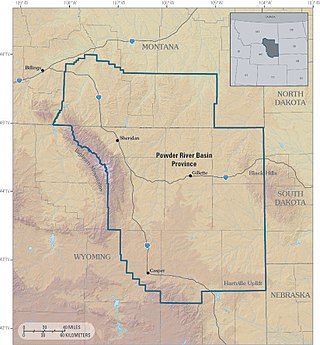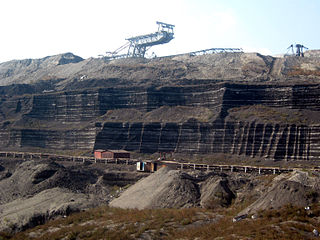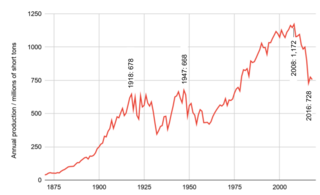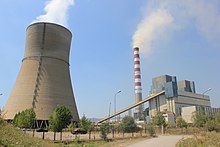
Lignite often referred to as brown coal, is a soft, brown, combustible, sedimentary rock formed from naturally compressed peat. It has a carbon content around 25–35%, and is considered the lowest rank of coal due to its relatively low heat content. When removed from the ground, it contains a very high amount of moisture which partially explains its low carbon content. Lignite is mined all around the world and is used almost exclusively as a fuel for steam-electric power generation.

Anthracite, also known as hard coal and black coal, is a hard, compact variety of coal that has a submetallic lustre. It has the highest carbon content, the fewest impurities, and the highest energy density of all types of coal and is the highest ranking of coals.

Coal mining is the process of extracting coal from the ground or from a mine. Coal is valued for its energy content and since the 1880s has been widely used to generate electricity. Steel and cement industries use coal as a fuel for extraction of iron from iron ore and for cement production. In the United Kingdom and South Africa, a coal mine and its structures are a colliery, a coal mine is called a "pit", and above-ground mining structures are referred to as a "pit head". In Australia, "colliery" generally refers to an underground coal mine.

The Powder River Basin is a geologic structural basin in southeast Montana and northeast Wyoming, about 120 miles (190 km) east to west and 200 miles (320 km) north to south, known for its extensive coal reserves. The former hunting grounds of the Oglala Lakota, the area is very sparsely populated and is known for its rolling grasslands and semiarid climate.

NLC India Limited (NLC) is a central public sector undertaking under the administrative control of the Ministry of Coal, Government of India. It annually produces about 30 million tonnes of lignite from opencast mines at Neyveli in the state of Tamil Nadu in southern India and at Barsingsar in Bikaner district of Rajasthan state. The lignite is used at pithead thermal power stations of 3640 MW installed capacity to produce electricity. Its joint venture has a 1000 MW thermal power station using coal. Lately, it has diversified into renewable energy production and installed 1404 MW solar power plant to produce electricity from photovoltaic (PV) cells and 51 MW electricity from windmills.

The economy of Kosovo is a transition economy. Kosovo was the poorest province of the former Yugoslavia with a modern economy established only after a series of federal development subsidies in the 1960s and the 1970s.
Coal mining regions are significant resource extraction industries in many parts of the world. They provide a large amount of the fossil fuel energy in the world economy.

The Miraš open-cast coal mines are lignite coal mines in Kosovo operated by the Kosovo Energy Corporation (KEK).

Coal in India has been mined since 1774, and India is the second largest producer and consumer of coal after China, mining 777.31 million metric tons in FY 2022. Around 30% of coal is imported. Due to demand, supply mismatch and poor quality with high ash content, India imports coking coal to meet the shortage of domestic supply. Dhanbad, the largest coal producing city, has been called the coal capital of India. State-owned Coal India had a monopoly on coal mining between its nationalisation in 1973 and 2018.

Coal mining is an industry in transition in the United States. Production in 2019 was down 40% from the peak production of 1,171.8 million short tons in 2008. Employment of 43,000 coal miners is down from a peak of 883,000 in 1923. Generation of electricity is the largest user of coal, being used to produce 50% of electric power in 2005 and 27% in 2018. The U.S. is a net exporter of coal. U.S. coal exports, for which Europe is the largest customer, peaked in 2012. In 2015, the U.S. exported 7.0 percent of mined coal.
Rovinari Coal Mine is an open-pit mining exploitation, the largest in Romania, located in Rovinari, Gorj County. The legal entity managing the Rovinari mine is the National Company of Lignite Oltenia which was set up in 1997.
Natural resources are abundant in Kosovo. Kosovo is mainly rich in lignite and mineral resources such as: coal, zinc, lead, silver and chromium, but also with productive agricultural land. Kosovo is also rich in forests, rivers, mountains and soil; Kosovo is especially rich in coal, being aligned among European countries as the third with the largest coal reserves. Kosovo possesses around 14,700 billion tons of lignite in reserves, which aligns Kosovo as the country with the fifth largest lignite reserves in the world.

The Visonta Coal Mine ([]) is an open pit lignite mine located near Gyöngyös, Heves County, in Hungary. It is the smallest lignite mine in Hungary out of three lignite mines in total. The mine has coal reserves amounting to 400 million tonnes of lignite, one of the largest coal reserves in Europe and the world and has an annual production of 3.9 million tonnes of coal.

RB Kolubara is a Serbian coal mining and smelting complex with headquarters in Lazarevac, Kolubara District. The mine has coal reserves amounting to 2.2 billion tonnes of lignite, one of the largest lignite reserves in Europe, and it produces 22.6 million tonnes of coal per year.

Elbistan coalfield, also known as Afşin Elbistan Lignite Reserve, is a large lignite coalfield located in the south-east of Turkey in Kahramanmaraş Province. Elbistan is the field with the most coal in Turkey. Kışlaköy coal mine now mines the field. 200 million tons of CO2 were emitted by burning lignite from this field before 2016, and 2.4 billion tons could be emitted in future. The lignite is high in sulfur and moisture, and only has 1,000 to 1,500 kcal/kg, or less than 5 MJ/kg, which is a quarter of typical thermal coal. The coalfield supplies the Afşin-Elbistan power stations.

The electricity sector of Kosovo relies on coal-fired power plants and is considered one of the sectors with the greatest potential of development. The inherited issues after the war in Kosovo and the transition period have had an immense effect on the progress of this sector.

Kosovo has a slowly developing plain industry. In 2009, the Industry accounted for 22.60 of GDP and a general workforce of 800,000 employees. It's on 150 th place, compared to the rest of the world. There are numerous reasons for this kind of stagnation, ranging from consecutive occupations, political turmoil and the recent Kosovo War (1999).
Kosova e Re, also known as the New Kosovo project, is a plan of the Government of the Republic of Kosovo to build a new 500 MW power plant near Prishtina, to rehabilitate the existing Kosovo B power plant and completely shut down the Kosovo A power plant which is considered the largest source of pollution in Kosovo. It also includes the development of a new lignite mine in order to meet the needs of the Kosovo B and the newly constructed power plant. It is estimated to cost US$2 billion.

Coal supplies over a quarter of Turkey's primary energy. The heavily subsidised coal industry generates over a third of the country's electricity and emits a third of Turkey's greenhouse gases.

The Rheinisches Braunkohlerevier, often called the Rhenish mining area, is a lignite mining area or district in the Cologne Bay, on the northwestern edge of the Rhenish Slate Mountains. The mining of lignite using the open pit method has had a significant impact on the landscape here and led to the formation of several important industrial sites. The area includes the Zülpicher and Jülicher Börde, the Erft lowlands and the Ville, making it the largest lignite mining area in Europe. To a lesser extent clay, silica sand and loess are mined here. The area is the only active lignite mining area in what was West Germany during German partition and contains the mines with the largest surface area, greatest depth, and biggest annual output of coal.





















